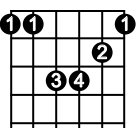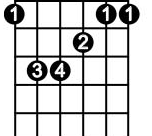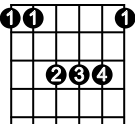Please read previous articles before reading on.
Understanding Barre Chords(part 1)
Understanding Barre Chords(part 2)
Hopefully you now have an uderstanding of the 4 primary barre chord shapes and how they relate to the string from which they get their ‘root’ note.
Now if you’ve been messing around applying the info from these articles you may have noticed or been confused by something.
Let me give an example.
You’re looking for C# minor
As in the 2nd article you would play this chord,
You would play the following minor chord shape at the 4th fret,
To get the ‘C#’ we need to find the note on the ‘A’ string,
But there is a second way of playing this chord using the following shape from our first article,
Minor barre chord shape
Remembering that the above string is tied to the ‘E’ string, we need to find the ‘C#’ on the ‘E’ string.
Find the ‘C’ – it’s on the 8th fret – sharpen the note to raise it(move) up 1 fret to the 9th Fret.
So by playing the following shape on the 9th fret you will have another way of playing a C# minor chord,
The same principle can be applied to the B flat major chord,
First let’s find the note,
So from the pictures above we have found our ‘Bb’ but this is on the ‘E’ string.
What about the ‘A’ string ?
Let’s have a look.
So we have two positions for our root note.
If we play the following barre chord shape at the 6th fret as indicated in the picture we’ll be playing Bb major
If we play the following barre chord shape below at the 1st fret as indicated in the picture below we’ll again be playing Bb major.
It’s confusing but worth the hassle.
If you’re still unsure try testing yourself and seeing if you’re correct by using untidy music’s free online barre chord dictionary here.
How do you know which version to use though?
Well it’s down to what your playing.
Sound plays a big part but economy of movement plays a part as well.
Experimenting with it is in my mind the best way of getting to grips with these questions.
Use your ear first then apply common sense.
Have fun.











